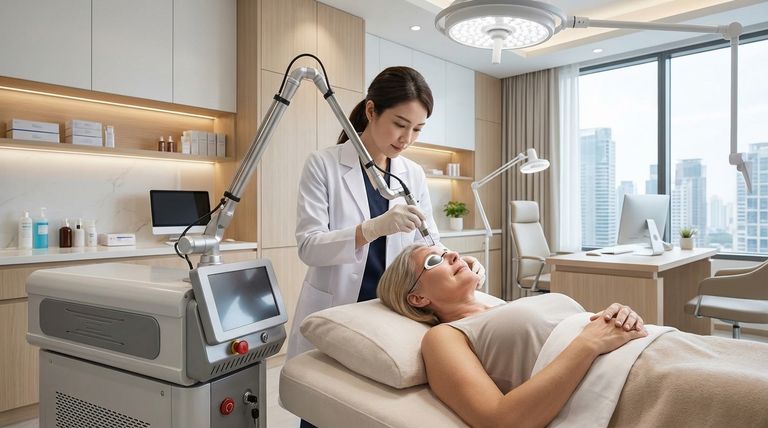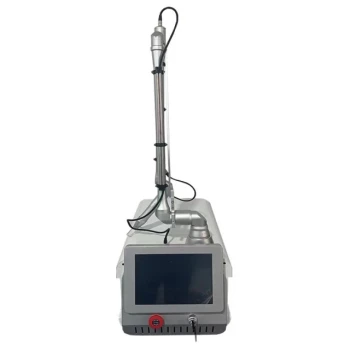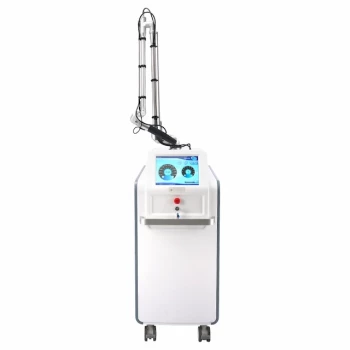On average, a highly effective CO2 laser treatment can make you appear 8 to 10 years younger. This significant rejuvenation is typically the result of an aggressive treatment setting designed to address substantial signs of aging. For example, a 55-year-old patient may look closer to 46 after the procedure and full recovery.
While the "10 years younger" result is achievable, it represents the upper end of what's possible. The actual outcome is a spectrum that depends entirely on the treatment's intensity, which directly correlates with the required healing time and potential risks.

What Influences the "Years Younger" Result?
The number of years a CO2 laser can seemingly erase is not fixed. It is the outcome of a careful calculation involving your skin's condition, the technology used, and the skill of the person performing the procedure.
The Critical Factor: Treatment Intensity
The single biggest determinant of your result is the intensity of the laser setting. A "highly effective" treatment, as mentioned, is often a fully ablative one, meaning it removes the entire outer layer of skin (epidermis).
Milder options, known as fractional CO2 treatments, create microscopic channels in the skin while leaving surrounding tissue intact. This approach stimulates collagen and provides significant improvement with less downtime, but the results are less dramatic than a fully ablative procedure.
Your Skin's Starting Condition
The outcome is relative to your starting point. An individual with deep wrinkles, significant sun damage, and poor skin texture has more room for dramatic improvement than someone with only fine lines.
The Practitioner's Skill
An experienced, board-certified dermatologist or plastic surgeon knows how to tailor the laser's depth and energy to your specific skin type and goals. Their expertise is crucial for maximizing results while minimizing risks like scarring or pigmentation changes.
Understanding the Trade-offs: Intensity vs. Downtime
The decision to pursue a CO2 laser treatment involves a clear trade-off between the result you want and the recovery you are willing to endure.
Aggressive (Fully Ablative) Treatments
This is the path to the most dramatic, 8-10 year rejuvenation. By removing the entire surface layer of the skin, it triggers a powerful healing and collagen-rebuilding response.
However, this intensity requires significant downtime, often two weeks or more of social downtime, followed by several months of skin redness. The risk of complications is also higher.
Moderate (Fractional) Treatments
Fractional CO2 lasers offer a balance. They can still produce remarkable results, but often require a series of treatments to achieve the desired effect.
The primary benefit is a much shorter recovery period, often just a few days to a week. While a single treatment might not take a full decade off, a planned series can achieve a powerful cumulative effect with far less disruption to your life.
Beyond the Number: The Qualitative Changes
Focusing solely on a number misses the true goal of the procedure. The appearance of youth is created by tangible improvements in skin quality.
Improved Skin Texture
The laser resurfacing process replaces rough, damaged skin with a new, smoother, and more radiant surface.
Reduction in Wrinkles
CO2 lasers are highly effective at softening or erasing fine lines and significantly reducing the depth of even the most stubborn wrinkles, particularly around the eyes and mouth.
More Even Skin Tone
The treatment effectively removes layers of sun-damaged skin, which eliminates sun spots, age spots, and other forms of discoloration for a more uniform complexion.
Noticeable Skin Tightening
The heat from the laser energy stimulates a massive collagen production response deep within the skin. This new collagen matrix tightens and firms the skin over the 6-12 months following the procedure.
Making the Right Choice for Your Goal
To set realistic expectations, you must align the treatment approach with your personal goals and tolerance for recovery.
- If your primary focus is maximum rejuvenation in a single treatment: An aggressive, fully ablative CO2 laser is the most direct path to an 8-10 year reduction in appearance, but requires a significant commitment to downtime.
- If your primary focus is noticeable improvement with minimal disruption: A series of milder, fractional CO2 treatments is a better fit, offering powerful, gradual results with a much faster recovery after each session.
- If your primary focus is targeting specific issues like texture or pigmentation: Milder fractional treatments are often sufficient to achieve excellent results without the intensity and recovery of a fully ablative procedure.
Ultimately, a successful outcome is achieved by matching the right technology to your specific goals in consultation with a qualified expert.
Summary Table:
| Factor | Impact on Result |
|---|---|
| Treatment Intensity | Fully ablative for maximum results (8-10 years), fractional for milder improvement |
| Skin's Starting Condition | More aging signs = greater potential for dramatic improvement |
| Practitioner's Skill | Crucial for maximizing results and minimizing risks |
| Downtime vs. Result | Aggressive treatment = longer recovery; fractional = quicker recovery |
Ready to Turn Back the Clock on Your Skin?
At BELIS, we specialize in professional medical aesthetic equipment, including advanced CO2 laser systems designed for medical aesthetics clinics and premium beauty salons. Our technology empowers practitioners to deliver safe, effective, and dramatic rejuvenation results for their clients.
Partner with BELIS to offer your clients a proven path to younger-looking skin.
Contact our experts today to learn how our CO2 laser solutions can enhance your service offerings and patient outcomes.
Visual Guide

Related Products
- Fractional CO2 Laser Machine for Skin Treatment
- Fractional CO2 Laser Machine for Skin Treatment
- Pico Laser Tattoo Removal Machine Picosure Picosecond Laser Machine
- Pico Picosecond Laser Machine for Tattoo Removal Picosure Pico Laser
- EMSlim RG Laser Body Sculpting and Slimming Machine
People Also Ask
- How often should you do fractional CO2 laser? The 4-6 Week Rule for Optimal Results
- How long after a CO2 laser will I see results on my face? A Timeline for Transformation
- What are medical lasers used for? Precision Tools for Surgery and Skin Treatments
- Is CO2 laser for all skin types? A Critical Guide to Skin Type Safety and Risks
- What does a CO2 laser do to your face? Achieve Profound Skin Resurfacing & Renewal



















